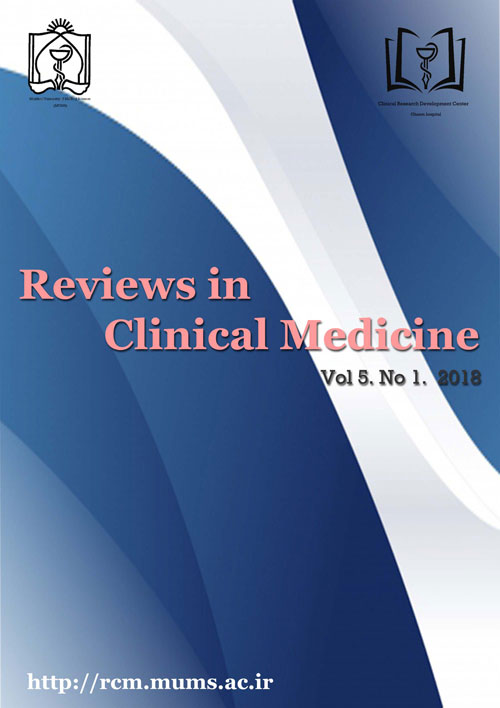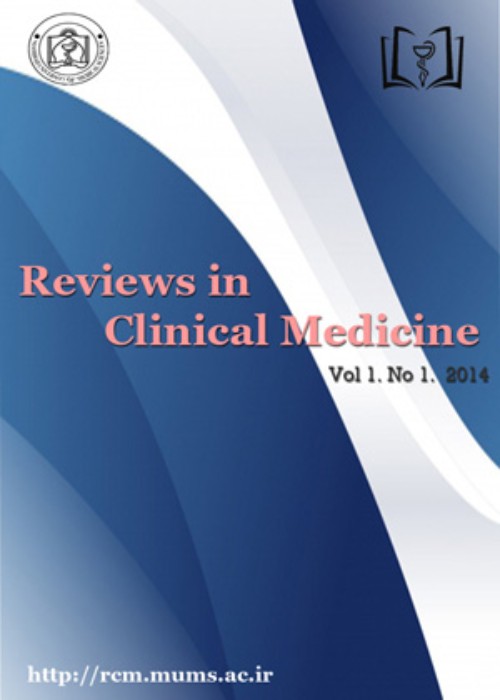فهرست مطالب

Reviews in Clinical Medicine
Volume:5 Issue: 1, Winter 2018
- تاریخ انتشار: 1397/01/09
- تعداد عناوین: 8
-
Pages 1-7Pulmonary arterial hypertension (PAH) is characterized by the mean pulmonary artery pressure of more than 25 mmHg and pulmonary artery wedge pressure of less than 15 mmHg evidenced by right-heart catheterization. In the classification of PAH, some subgroups are defined as primary or secondary PAH based on the underlying etiologies of the disease. Early episodes of PAH have been reported to occur at younger ages and in women in idiopathic or familial forms with the survival rate of 1-3 years. According to recent registries, the affected patients are older and have better survival rates. Some of the key elements in the pathophysiology of PAH include intima and media proliferation, vascular remodeling, and blood coagulation, which could increase the defiance of pulmonary vascularity, so that the cellular and molecular pathways would be able to induce PAH through specific mechanisms. Although no pathognomonic signs and symptoms have been reported in the literature, the most prominent manifestations of PAH are associated with disorders such as heart failure. Currently, PAH is known as a severe and occasionally life-threatening multifactorial clinical condition. Considering endothelial dysfunction, vasoconstriction, inflammatory reactions, and platelet aggregation as the main pathophysiological arms of the disease, specific treatment approaches have been proposed to inhibit these manifestations. These methods result in the effective treatment response, as well as the proper early and late outcomes of PAH. Due to the high incidence of cardiovascular diseases and the associated progressive life-threatening conditions, such as heart failure and PAH in the Iranian population, identification of the etiological, pathophysiological, diagnostic, and novel therapeutic approaches for PAH is essential to the proper management of this clinical condition.Keywords: Arterial Pressure, Hypertension, Pulmonary Artery
-
Pages 8-11Eosinophilic esophagitis (EoE) is a chronic immune condition affecting children and adults. Dysphagia and food impaction are the main symptoms; however, reflux-like symptoms may also be present. The diagnosis of EoE is made with endoscopic evaluation for dysphagia, and its definitive diagnosis requires biopsy confirmation. The criteria for active EoE are defined as the symptoms of esophageal dysfunction, eosinophilic tissue infiltration (eosinophil count of at least 15 eosinophils per high-power field), and exclusion of other possible causes of esophageal eosinophilia. EoE is more prevalent in patients suffering from atopic conditions; therefore, allergic conditions may play an important role in the development of the disease. However, the etiology and pathophysiology of the disease are not completely understood. Elimination diets are considered as the first-line therapy in children; nevertheless, this approach appears to be less effective in adults, who often require steroids. Despite medical treatments, EoE is complicated in some cases by esophageal stricture and stenosis that require additional endoscopic treatments.Keywords: Cytokines, Dysphagia, Proton pump inhibitors
-
Pages 12-15Congenital heart defect (CHD) is the most common type of congenital malformation in live births with a wide and variable spectrum in each population. The prevalence of this malformation is reported to be 8 cases per 1,000 live births. The CHD is also accompanied by multiple complications, such as prematurity, low birth weight, termination of pregnancy, mortality, and morbidity. The concomitant of this defect with extra-cardiac anomalies result in the enhancement of mortality and morbidity. Due to the importance of CHD and role of genetic and environmental factors on CHD, prenatal diagnosis is an issue of fundamental importance. The prenatal diagnosis increases the survival rate and reduces complications, mortality, and morbidity. Fetal echocardiography as a non-invasive and safe method enables the pediatric cardiologists to diagnose CHD prenatally with high sensitivity and specificity. Regarding this, the present study was conducted with the aim of reviewing the literature on the prenatal diagnosis of CHD using fetal echocardiography. Based on the reviewed studies, the role of fetal echocardiography and its indications were defined. Accordingly, fetal echocardiography was suggested as a profitable method for the prenatal diagnosis of CHDs even in the low-risk pregnancies.Keywords: Congenital heart disease, Fetal echocardiography, Prenatal diagnosis
-
Pages 16-18Occasionally, lymphoma involves the adrenal glands; however, primary adrenal lymphoma (PAL) is rare and only few cases have been reported. We report a case of a 59-year-old female with primary adrenal diffuse large B-cell lymphoma (DLBCL) manifested by weakness, fatigue, anorexia, and hyper pigmentation of skin. The patient initially responded to intravenous hydrocortisone in large doses by total remission of the symptoms. An abdominal computed tomography scan showed a hypodense mass in the right subdiaphragmatic space, which was suggestive of an adrenal gland tumor with adjacent liver involvement. Additionally, a smaller lesion with similar characteristics was found in the left adrenal gland. The results obtained from adrenal gland needle biopsy confirmed the diagnosis of DLBCL. Moreover, primary laboratory findings demonstrated hyponatremia, hyperkalemia, fasting blood sugar level of 153 mg/dl, and alkaline phosphatase level of 663 U/L. The mentioned symptoms and laboratory findings were indicative of adrenal insufficiency. After about 2 months, her level of consciousness decreased and urinary and fecal incontinence occurred. Therefore, brain involvement was suspected, and magnetic resonance imaging of the brain showed heterogeneous enhancement (24.8 mm) in the posterior aspect of the left temporal lobe together with patchy foci of enhancement in around the ventricular areas of the brain that showed metastatic lesions of PAL. This case should remind clinicians that PAL may be a cause of adrenal incidentaloma, especially when the patient presents with the symptoms of adrenal insufficiency.Keywords: Diffuse large B, cell lymphoma, Metastasis, Primary adrenal lymphoma
-
Pages 19-22Vulvar cancer is a rare malignancy representing less than 1% of the cancers, which is diagnosed in women with a high incidence of local recurrence and distant metastasis and carries a poor prognosis. We presented a 51-year-old woman with a lesion in the vulva appeared for three months. The lesion was large, ulcerative, hemorrhagic, tender, and mobile with no lymphadenopathy. Excisional biopsy demonstrated a high-grade malignant neoplasm with lymphovascular invasion. Based on the immunohistochemistry test, the patient was diagnosed with neuroendocrine carcinoma with poorly differentiated tumor. In the diagnostic workup, there were two small lymph nodes on the left inguinal area. The patient was subjected to radical vulvectomy and bilateral illioinguinal lymphadenectomy. In addition, she was prescribed to undergo adjuvant chemotherapy for three cycles. Subsequently, she was given hyperfractionated radiotherapy in the pelvis and bilateral inguinals concurrently with chemotherapy. In the last follow-up visit in 32 months later, the patient was disease-free in the physical examination, and the laboratory tests and imaging findings were normal.Keywords: Neoplasms, Neuroendocrine tumor, Vulva
-
Pages 23-25Thumb hypoplasia only in the intrinsic thenar muscles is a rare condition; this defect might be accompanied with cardiac diseases (Holt-Oram syndrome), ocular anomalies, and vascular anomalies of the hand and wrist (Okihiro syndrome). In addition, this condition may be detected in hypereosinophilic syndrome (HES), which gives rise to other hand anomalies, as well. Unilateral or bilateral absence of isolated thenar muscles is another rare abnormality.
In this study, we presented a case of Cavanaghs syndrome in an eight-year-old boy with right-sided thenar hypoplasia who had difficulty in thumb opposition.
For the treatment, the patient underwent abductor digiti minimi (ADM) opponensplasty. After three years of follow-up, he regained thumb opposition and was symptom-free. Care must be taken to avoid misdiagnosis of thenar atrophy/hypoplasia with carpal tunnel syndrome in case of children.Keywords: Cavanagh's syndrome, Hypoplasia, Opponensplasty, Thenar -
Pages 26-28Bacillus anthracis is an aerobic, gram-positive, and spore-forming Bacillus species. The most common form of anthrax infection is the cutaneous form. The infection usually develops several days after exposure to products of infected animals and manifest as black sore with severe swelling on the skin.
A 52-year-old female with a black and swollen lesion on her index finger presented to Ghaem Hospital, Mashhad, Iran, in October 2015. Biopsy and swab culture were performed immediately. Cutaneous anthrax was characterized by microscopic examination of B. anthracis spore using Gram staining. The patient was then treated with antibiotics after diagnosis.
According to the reports of Provincial Health Center of Khorasan Razavi, northeast of Iran, no cases of anthrax have been reported in humans since 2013. There were neither occupational risk factors, nor any routine predisposing factors for acquiring anthrax in this woman. Although this patient is the first case reported with cutaneous anthrax since the past three years, two cases of sheep anthrax have been reported in Khorasan Razavi Province during 2013-2015. This patient had a history of contact with the skull of a slaughtered sheep. The patient was treated after making correct and rapid diagnosis and sufficient antibiotic therapy.Keywords: Bacillus anthracis, Cutaneous anthrax, Zoonotic disease -
Pages 29-32IntroductionEnema or hoqne is a therapeutic approach used for a wide range of diseases in the Iranian traditional medicine. The use of this method dates back to thousands of years to Hippocrates and Galen. The aim of this study was to review the history of enema and its methods and indices in the Iranian medicine and other complementary medicine.MethodsThis review study was conducted on the Iranian medicine textbooks and articles published in the international databases, including Google Scholar, PubMed, Embase, and Scopus, as well as the Iranian databases, such as SID and Magiran. The searching process was performed using the following keywords: Hoqne, Enema, Vasta, Basta, and Complementary and Alternative Medicine (CAM). There was no limitation regarding the publication data of the included studies.ResultIn the Iranian medicine, the term hoqne is equivalent to enema. Enema is used in various diseases of the brain, respiratory system, digestive system, urogenital system, and musculoskeletal system, as well as systemic diseases. Enema is one of the five main therapies in the Indian medicine or Ayurveda. In other types of complementary medicine, including Chinese medicine, this procedure has therapeutic applications. Although enema has been recognized as a diagnostic method in modern medicine, it has been considered as a therapeutic approach in the recent years.ConclusionAccording to the findings of the reviewed studies, enema is a major therapeutic focus in complementary medicine, part of which has been confirmed in the recent studies. Given the low side effects and high success rate of this treatment, it can be used as a supplemental therapy for the management of poisoning, febrile seizures, prolonged functional constipation, and chronic kidney disease, as well as the prevention of swelling. However, this theory requires further investigation and targeted clinical trials. This method has been recently identified and updated as a preventive and therapeutic modality.Keywords: Enema, Complementary medicine, Integrative medicine, Persian Medicine


